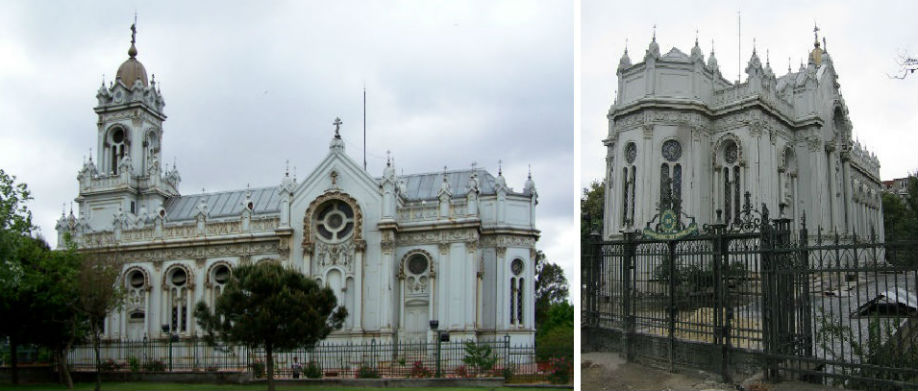The Bulgarian St. Stephen Church ( Turkish: Sveti Stefan Kilisesi ), also known as, is a Bulgarian Orthodox Church in, Istanbul, Turkey, famous for being made of cast iron. The church belongs to the Bulgarian minority in the city. The Bulgarians of the Ottoman Empire used to pray at the churches of the Phanar Orthodox Patriarchy, but due to nationalistic movements, Bulgarians were allowed a national church in the 19th century, the Bulgarian Exarchate.
The richly ornamented church is a three-domed cross-shaped basilica. The altar faces the Golden Horn and a 40 m-high belfry, the six bells of which were cast in Yaroslavl, rises above the narthex. Initially, a small wooden church was erected on the shore of the Golden Horn between Balat and Fener squares (near Eyüp district), where the current church is located. A house was donated by the statesman Stefan Bogoridi and it was reorganized as a wooden church. It was inaugurated on 9 October 1849 and became an important site of the Bulgarian National Revival. The Ottoman royal decree of 28 February 1870 establishing the Bulgarian Exarchate was first read in the church.
After the original wooden structure suffered from a fire, the larger current building was constructed at its place. An iron frame was preferred to concrete reinforcement due to the weak ground conditions. The construction plans were prepared by Hovsep Aznavur, an Armenian of Istanbul origin. An international competition was conducted to produce the prefabricated parts of the church, won by an Austrian company, R. Ph. Waagner. The prefabricated parts, weighing 500 tons, were produced in Vienna in 1893-1896 and transported to Istanbul by ship through the Danube and the Black Sea.
After one and a half years’ work, the church was completed in 1898 and inaugurated by Exarch Joseph on 8 September that year. The main skeleton of the church was made of steel and covered by metal boards. All the pieces were attached together with nuts, bolts, rivets or welding. In terms of architecture, the church combines Neo-Gothic and Neo-Baroque influences.
St. Stephen was the product of 19th century experimentation with prefabricated iron churches. The British, who invented corrugated iron in 1829, manufactured portable iron churches to send to far-flung colonies like Australia. The Eiffel Tower’s creator, French engineer Gustave Eiffel, designed iron churches that were sent as far as the Philippines and Peru. Now St Stephen is one of the world’s few surviving prefabricated cast iron churches.
On December 27, 2010, Saint Stephen’s feast day, a celebratory mass was held at the church in honor of its patron saint. Attending were the Vratsa metropolitan Kalinik, bishop Naum, Chief Secretary of the Bulgarian Holy Synod, and representatives of the “St. Stephen Church” Foundation. Honoring the celebration the dome of the church was gold-plated using funds donated by the Bulgarians of Plovdiv.
In addition to the St. Stephen Church, there is another Bulgarian Orthodox church in Istanbul the St. Demetrius Church in Feriköy.



Too bad, looked cool from the outside. Not sure when it will reopen guard spoke no English. We tried to visit on a Sunday, maybe you’d have better luck another day.
Bulgarian St. Stephen Church
√ The construction of the building is unusual.
√ It is portable can be moved on rails.
√ Stone workis are great.
Saint Stephen Bulgarian Orthodox Church
I was amased how this slabs of cast iron hoisted together make such an elegant building. Unique building technique best seen at the shore of Golden Horn.
Very beautiful building with interesting history.
Amazing to know the story of the church- that it's been built in Austira from steel and constructed over night in İstanbul!
December 23rd we decided to take a ferry from central Istanbul up the Golden Horn to Balat, the area that housed the majority of the city’s Jewish population. As we left the ferry at the municipality of Fatih, we immediately found ourselves by the church dedicated to St. Stephen. It is one of two church buildings serving the Bulgarian minority in the city.
Church made entirely of iron, spilling from the Danube in Vienna to Istanbul by sea.
Very characteristic church.